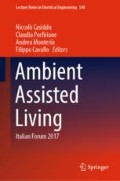Abstract
Housing is an important part of life that has become increasingly important over the years. For as long as it is possible, most older people want to stay in their own homes, and to do this they must have freedom of movement in their own space. In this sense, adapting the living space of the elderly in terms of accessibility and security is a fundamental issue, because with age almost everyone experiences some loss of mobility and increasing difficulty bending, stretching and weight bearing. The medical realities of ageing—the physical, sensory and cognitive impairments that come to everyone eventually, must not to be ignored. However, we must recognize that many older people are disabled by the design of the environment around them, rather than intrinsically disabled. In this direction, some of these needs can be met by adapting existing homes, but when alteration is not feasible, design can provide products and services able to improve self-sufficiency and independence. There is potential for houses, furnishing and equipment to be much better fitted to the needs of an ageing population and, in addition, there is a wealth of design guidance and expertise available. On this basis Restoqui represents an opportunity to create a platform where customers can find a sort of catalogue of all the possible design solutions to adapt houses to their needs. The research is still at concept level but it deals with the needs of interior specialists, elderly users and their caregivers as well as geriatricians in order to create a virtual container that brings different skills together.
Access this chapter
Tax calculation will be finalised at checkout
Purchases are for personal use only
References
AGE Platform Europe. (2011). How to promote active ageing in Europe. EU support to local and regional actors—European Commission, Committee of the Regions. Available via http://eurohealthnet.eu/media/new-brochure-how-promote-active-ageing-europe-eu-support-local-and-regional-actors. Cited 2. December 1, 2011.
Myerson, J. (2017). New old introduction. In New old. Designing for our future selves (pp. 12–17). The Design Museum.
Torringtoon, J. (2017). Reasons for moving home in England, by age. In New old. Designing for our future selves (pp. 62–69). London: The Design Museum.
ISTAT. (2015). Rapporto annuale 2015. La situazione del paese. Available via https://www.istat.it/it/archivio/159350. Cited July 31, 2017.
Older Persons Housing Design: A European Good Practice Guide. (2007). Available via http://www.brighton-hove.gov.uk/content/housing/general-housing/welhops-welfare-housing-policies-senior-citizens-0. Cited July 31, 2017.
Torringtoon, J. (2015). Future of Ageing: adapting homes and neighbourhood. Available via https://www.gov.uk/government/publications/future-of-ageing-adapting-homes-and-neighbourhoods. Cited July 31, 2017.
Wel hops (WELfare HOusing Policies for Senior citizens). (2007). Older persons housing design: A European good practice guide.
Goodman, C. (2011). Lifetime homes design guide. London: IHS BRE Press for Habinteg Housing Association.
Cody, M., Dunn, D., Hoppin, S., & Wendt, P. (1999, October). Silver surfers: Training and evaluating internet use among older adult learners. Communication Education, 48(4), 269–286.
Pericu S. (2017). Designing for an ageing society: Products and services. The Design Journal, 20(sup 1), S2178–S2189. https://doi.org/10.1080/14606925.2017.1352734 Design for Next. In L. Di Lucchio, L. Imbesi, & P. Atkinson (Eds.), Proceedings of the 12th European Academy of Design Conference (pp. 1–13). Sapienza University of Rome, 12–14 April 2017. Abingdon: Taylor & Francis Group. Peer review. Pericu, S. (2014). Laboratori di design tra generazioni: dalle esigenze ai concept (pp. 61–65). AeA, Abitare e Anziani, Anno 15- n° 2/2014.
Zallio, M., Berry, D. & Casiddu, N. (2017). Adaptive environments for enabling senior citizens: An holistic assessment tool for housing design and IoT-based technologies. In 2016 IEEE 3rd World Forum on Internet of Things (WF-IoT)—Reston, VA, USA, 12–14 December 2016. https://doi.org/10.1109/wf-iot.2016.7845463.
Lee, J., & Collie, G. (2017). The age of no retirement. Available via www.ageofnoretirement.org. Cited July 31, 2017.
Plumbe, C., Berg, M., Kunur, M., Eikhaug, O., Gheerawo, R., & Valfort, M. (2010). Innovating with people. The business of inclusive design. Norwegian Design Council, Oslo: Fladby AS.
McGrath, L. (2015). How to meet the Web Content Accessibility Guidelines 2.0.
Rosenfeld, L., & Morville, P. (2002). Architettura dell’informazione per il World Wide Web (p. 225). Milano: Hops Libri.
Rosenfeld, L., & Morville, P. (2002). Architettura dell’informazione per il World Wide Web (pp. 39–46). Hops Libri: Milano.
Kalbach, J. (2007). Designing web navigation: Optimizing the user experience (p. 31). Sebastopol: Linda Leflamme.
Krug, S. (2014). Don’t make me think (pp. 22–23). Berkeley: New riders.
Veen, J. (2001). Web design arte e scienza (pp. 40–42). Apogeo: Milano.
Boulton, M. (2009). A practical guide to designing for the web (pp. 75–163). Robert Mills: Penarth.
Acknowledgements
Restoqui is a concept developed in a research activity coordinated by M. Benedetta Spadolini of the Department of Architecture and Design in 2015. The research group includes Silvia Pericu, Ami Licaj, Francesca Stabilini and Chiara Olivastri.
Contributions to the paper were made by Silvia Pericu (Abstract, 1. Introduction, 2. The concept, 4. Discussion) and Ami Licaj (3. Designing Restoqui, 5. Conclusion).
Author information
Authors and Affiliations
Corresponding author
Editor information
Editors and Affiliations
Rights and permissions
Copyright information
© 2019 Springer Nature Switzerland AG
About this paper
Cite this paper
Pericu, S., Licaj, A. (2019). RESTOQUI: A Platform to Live at Home All Your Life. In: Casiddu, N., Porfirione, C., Monteriù, A., Cavallo, F. (eds) Ambient Assisted Living. ForItAAL 2017. Lecture Notes in Electrical Engineering, vol 540. Springer, Cham. https://doi.org/10.1007/978-3-030-04672-9_3
Download citation
DOI: https://doi.org/10.1007/978-3-030-04672-9_3
Published:
Publisher Name: Springer, Cham
Print ISBN: 978-3-030-04671-2
Online ISBN: 978-3-030-04672-9
eBook Packages: EngineeringEngineering (R0)

